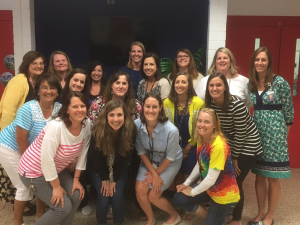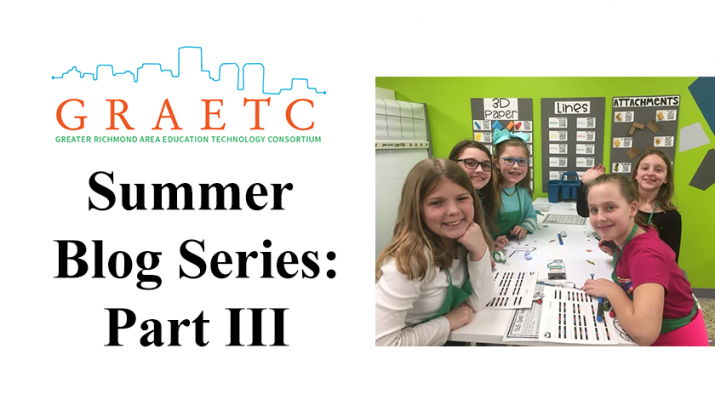In our final post in our three-part blog series highlighting the efforts of three Hanover County Public School teachers who have transformed learning spaces to empower students and to amplify learning, guest blogger Eliza Gemmill, Hanover County Public School elementary gifted resource teacher, shares the power of “to be.”
Brennan ran across the playground to catch me. Breathless, he said, “Teamwork. Don’t forget about teamwork.” Our students are functioning as engaged, confident, and empowered learners who are willing to chase me down in order to express themselves. As I prepared to write about the changes we have implemented, I turned to the experts – my students. I wondered what they would say about instruction this year. I simply engaged in individual conversations on the playground and offered a fill in the blank sentence. “The most important thing I have learned this year is…” Their answers framed my thinking about innovation and the importance of prioritizing project based learning to teach content. I expected to hear about multiplying fractions, organizing writing, or light and sound. Yet, almost all of them added “to be.” Of course, they were learning all the facts, procedures, and tools they needed to be academically successful; but when asked the most important thing they learned, they responded I have learned “ to be…” The changes we incorporated into our instruction were increased integration of content, engaged and motivated students, but the most important thing that they learned this year was “to be.”
So today, I write about becoming. Our teachers seek “to be” new and better instructionally. Our students are becoming innovators as we create relevant experiences that engage them in conversation and teamwork. Each of these short stories focuses on one of the words that the students shared with me that day on the playground.
The most important thing I have learned this year is…
To Be a Team Player – We began this process as a team. The Classroom of the Future Grant was written by the STREAM Team, sixteen teachers who shared their ideas, opinions, and research. Through discussions with county specialists, local university representatives, and the invaluable feedback and inspiration from my Gifted Resource Team we were able to create a clear vision for our dream classroom. Alicia Broughton helped us define a common language for our efforts and evaluate resources. Amy Faires, Susan Mudd, and Cindy Burns shared their expertise about SCRUM through countywide professional development. SCRUM has played an integral part of our success in the Innovation Studio. Using SCRUM in the classroom is a result of the incredible work occuring in Goochland County. Teachers are setting goals, sharing ideas, and helping one another as they implement innovative lessons using the resources in our new studio. We emphasize to students how important it is to reach out and appreciate each other’s strengths as we are all learners in this process.
To Have a Growth Mindset – Aprons for every student were an important addition to the Innovation Studio. This physical cue set the stage for each lesson. Everytime they put on the aprons we ask, “Why are you wearing aprons today?” Their response was, “We wear these aprons to show that we are ready to have a growth mindset as we try to tackle new challenges.” Teachers also wore aprons to signify their commitment to innovative instruction. It was almost like a pledge, and its repetition helped us emphasize the importance of a shift in our thinking.
To Be a Risk Taker – I announced my concerns about new projects as I introduced them to the students. Our conversation usually began with, “I have never done this before, but I want to try something new, and I will need your help.” Our students felt free to share feedback throughout projects so that we could make changes and improvements as we went. We modeled risk taking, reflection, and implementing immediate changes in our process when necessary.
To Be a Servant Leader – We discussed the concept of servant leadership when we introduced SCRUM as a framework for productivity and collaboration. We modeled servant leadership by asking, “How can I help?” Students anticipated opportunities for servant leadership during our stand up meetings that occured periodically throughout work sessions. That one simple question has changed the way that they interacted when working to overcome challenges.
To Be Kind – SCRUM groups were created based on student strengths. Recognizing and appreciating strengths in others allowed for building positive relationships and interactions. As part of our group work, students evaluated their own level of effort, flexible thinking, perseverance in problem solving, communication, and collaboration then, provide feedback to the others in their group. Our goal was to celebrate our strengths as we supported growth in our weak areas.
To Be a Communicator – The “pass it on” approach became an invaluable tool to help introduce new technologies to as many students as possible. In order to teach others about how to use a technology, the “student instructors” were not able to touch the technology. They were required to communicate clearly and concisely to help break down each step for the students that were learning the new technology. It works with entire classes partnering with other classes, or small groups within a classroom and sharing with each other.
To Be Respectful – Visitors came frequently and sometimes in large numbers: Business Owners, Principals, Teachers, and college students. As we prepared for these visits, we stopped to provide direct instruction about speaking to others about their learning process. We practiced shaking hands, making eye contact, and speaking loudly and clearly, and engaging in meaningful conversation by asking and listening to questions, as well as sharing responses. The ma’ams, sirs, and thank yous became habit. These choices showed respect to others and displayed respect for the learning process.
To Have Grit – Integrating new technologies presented challenges for both teachers and students. On a recent project that required students to program Spheros to travel across varied terrains, it took many groups over 50 attempts to find success. Students returned during recess and primetime to continue to persevere. Tears of joy followed the eventual success, and they moved to the next terrain to tackle that challenge.
To FLeRD – (Fail Fast, Learn, Renew, Do) Epic fails became a celebrated occurrence. Break Out Boxes offered many opportunities for failure and resilience. Teachers and students alike learned from failure. Recently, one of the most effective teachers I had the pleasure to work with decided to try a new lesson in the Innovation Studio. I came by to check in because I knew she was excited about it. As I walked in, chaos ensued. Students were in the process of cleaning up and the teacher immediately approached me obviously exasperated after the lesson. What she said let me know that we were all on the right track. She said, “I know what I will do differently next time.” Less than a week later, she was back with a new lesson that yielded incredible success.
The most important thing I learned this year is to be INNOVATIVE. The Classroom of the Future Grant enabled us to dream about what instruction could look like. Thanks to the Hanover Education Foundation that dream became a reality. None of this was possible without teachers that take risks, step out of their comfort zones, and try something new. Over the past few months, one particular class of fifth graders allowed me to grow and learn. They were truly my inspiration, and they exceeded my very high expectations on a daily basis. I am also blessed to work with incredible, flexible, and supportive teachers that make every lesson more meaningful with their enthusiasm and suggestions ;). It is because of all those things that I left that day from the playground with tears of pride for the most important thing the students learned this year was “to be…”
Authorship Information:
Eliza is a Gifted Resource Teacher at South Anna Elementary School, 2017 Hanover Education Foundation’s Classroom of the Future Winner, NBCT, 2017 REB Winner, and South Anna Elementary Teacher of the Year 2018. She enjoys the collaborative nature of her position and is blessed to work with an incredible Gifted Resource Team of teachers from across the county.

